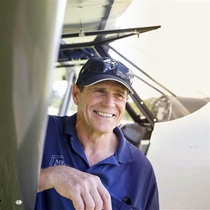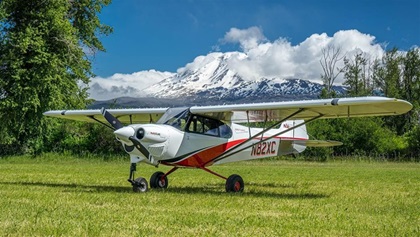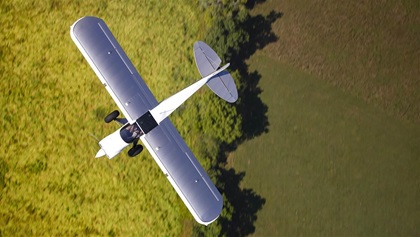Mud and dirt in its future
CubCrafters helps builders with the airplane of their dreams
Build your own cub








Sure, CubCrafters has sold many XCubs—about 60 of which have been delivered to buyers to date. The surprising part is that, after finishing its stringent, multi-million-dollar FAA Part 23 certification effort in 2016, CubCrafters has seen its Experimental-category business grow far faster.
The company, based in Yakima, Washington, expects to deliver about 100 new airplanes this year—and more than half of them will be Experimental and Light Sport models. And the lion’s share of those are FX–3 models made by individual builders in Yakima under the company’s pioneering builder-assistance program (see “Professional Help,” p. 64).
Each owner/builder comes to Yakima for a full week of fabricating aircraft parts ranging from wing ribs to carbon-fiber side walls. Then they go home for about 90 days while those parts are put together and the aircraft is covered with fabric and painted by CubCrafters employees.
Finally, owners return for two days of final assembly, which involves hanging the engine, propeller, and avionics; an FAA inspection; and—if all goes according to plan—obtaining an Experimental/amateur-built airworthiness certificate. CubCrafters test pilots perform the first flights.
“The building process was fun and interesting, and it allowed me to learn the airplane inside and out,” said David Gochenaur, an FX–3 owner and pilot in western Maryland. “You get to work alongside the welders and technicians on the assembly line. And the fact that they’re looking over your shoulder and observing what you’re doing provides a high degree of comfort in the finished product. I didn’t expect to enjoy the process nearly as much as I did.”
Gochenaur, 60, owns a construction business, but he says he’s never built an airplane and has no formal training in aircraft maintenance. “I’m not a mechanic by any stretch of the imagination.”
He’s a veteran pilot with instrument and multiengine ratings but had less than 50 hours of tailwheel experience—and none of it recent—at the time he chose to build an FX–3.
Gochenaur enrolled at TacAero, a flight school in ceaselessly windy Hood River, Oregon, for tailwheel training in a big-engine Super Cub that’s similar to an FX–3 in size and temperament.
“The flying was humbling at first—but also really challenging and enjoyable,” he said. “It was good preparation for flying the FX–3. When the time came, I felt ready.”
The FX–3 is a more refined, structurally strengthened, and higher-speed version of the original Carbon Cub—a Light Sport aircraft that’s limited to a maximum 1,320 pounds gross weight and a 120-knot top speed in level flight by LSA regulations.
The FX-3 allows options such as a more powerful engine (186 horsepower), a constant-speed propeller, larger fuel tanks, a higher gross weight, more payload, IFR instrumentation, and other performance enhancements. Gochenaur said he was drawn to the Experimental category because it allows more freedom to modify and operate the airplane as he wished while using non-TSO avionics and other accessories. His instrument panel is built around a Garmin G3X touchscreen primary flight display/multifunction display that was recently approved for installation in hundreds of Standard-category aircraft.
“I wanted to make my airplane IFR capable and legal,” he said. “The Experimental category allows me to do that in a common-sense, cost-effective way.”
 "You get to work alongside the welders and technicians on the assembly line. And the fact that they're looking over your shoulder and observing what you're doing provides a high degree of comfort in the finished product. I didn't expect to enjoy the process nearly as much as I did." —David GochenaurOne downside to the Experimental category is that the airplane can’t be used for commercial purposes. But Gochenaur said that wasn’t a drawback for him.
"You get to work alongside the welders and technicians on the assembly line. And the fact that they're looking over your shoulder and observing what you're doing provides a high degree of comfort in the finished product. I didn't expect to enjoy the process nearly as much as I did." —David GochenaurOne downside to the Experimental category is that the airplane can’t be used for commercial purposes. But Gochenaur said that wasn’t a drawback for him.
“The premise of this airplane is fun,” he said. “This is the airplane I’m going to keep until they scatter my ashes out of it.”
A CubCrafters test pilot did the first two hours of flying in Gochenaur’s FX-3—but the FAA required 40 hours of flight testing within 75 miles of Yakima before he was allowed to fly it home.
Gochenaur did that flying himself, and he said it was one of his favorite aspects of the FX-3 build experience.
“Eastern Washington and the Columbia River Valley are absolutely beautiful in winter,” he said. “On those cold, clear winter days, the airplane’s performance is just spectacular, and the scenery in that part of the country is amazing. I had the time of my life just flying around the local area logging the required flight time.”
CubCrafters has invested heavily in its builder-assist program and even built on-airport apartments to house builders during their stays in Yakima. An employee concierge manages all aspects of each build and makes sure all the materials and staff experts are available at the proper times.
“The inventory and raw materials have got to be ready for each builder,” said Pat Horgan, CubCrafters president. “They’re busy people, and their schedules are very tight. It takes a high degree of logistical effort and sophistication to make sure everything’s on hand for each builder as they go through the process.”
Each builder gets to know individual CubCrafters mechanics and technicians as they perform the required tasks of constructing “51 percent” of their aircraft to meet the FAA requirement for the amateur builder to build the major portion of the aircraft.
“They see everything that goes into producing their airplane—and they get to know our people quite well,” Horgan said. “They spend time with our front-line people, and that builds a very strong bond.”
Airplanes made by individual builders with factory assistance have the same warranty as other models, Horgan said. They undergo the same engineering, and they are held to the same performance and flight-test standards.
The Experimental-category EX–3 and FX–3 also benefit from the XCub program because they have adopted many of the same materials and components. The stick grips, iPad mounts, and even the ailerons on the XCub are identical to those on EX–3s and FX–3s.
Logistical considerations also limit the builder-assist program to no more than two visiting owners/builders per week—and the program is so popular that there’s a mounting backlog. An FX–3 buyer today, for example, would have to wait about one full year for a building slot, and it would take roughly 14 months to finish the process. Gochenaur made the construction of his FX–3 and flying it from the Northwest to the Mid-Atlantic a family affair. A nephew who’s also an aerospace engineer joined him in Yakima to take part in the construction process, and a brother who worked as a professional pilot in Alaska came along and coached him through the transcontinental ferry flight home.
“We seldom got higher than 1,500 feet above the ground all the way from the state of Washington to Maryland—and that’s a great way to see the country,” Gochenaur said.
Even though he envisioned flying the FX–3 purely for fun and adventure, Gochenaur said it makes an astonishingly good commuter. He keeps it on a grass strip at a farm in rural Maryland and flies it to an office in Northern Virginia as well as construction sites throughout the region.
“This airplane wasn’t supposed to be about practicality—but it’s been surprisingly helpful for just getting around this area,” he said.
“The real reason I got it was to go on hunting trips, fly to Alaska, and just get out there,” he said. “It looks pristine now—but I can assure you there’s going to be plenty of mud and dirt in its future.”
Email [email protected]

 A What?
A What? The idea of “builder-assist” programs has been radically reinterpreted over the last 15 years—and it has always been controversial.
The idea of “builder-assist” programs has been radically reinterpreted over the last 15 years—and it has always been controversial.

